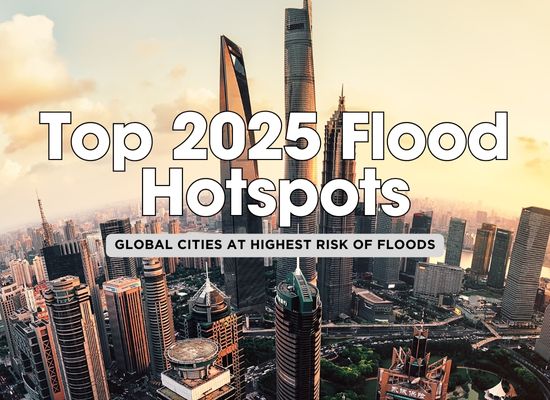As we move into 2025, the rising threat of climate change has placed several cities worldwide at the mercy of devastating floods. From rising sea levels to extreme weather events, these urban areas are increasingly vulnerable, putting millions of lives and billions of dollars in infrastructure at risk. Whether you’re a global traveler, an investor, or someone curious about the world’s shifting landscapes, understanding these at-risk cities can offer invaluable insights. Here’s a deep dive into the top five flood-prone cities and what makes them particularly vulnerable.
1️⃣ Jakarta, Indonesia 🇮🇩
- Why It’s at Risk: Jakarta is sinking at an alarming rate of 10 centimeters annually due to excessive groundwater extraction. Combined with rising sea levels and inadequate drainage systems, the city faces regular flooding, with over 40% of its land below sea level.
- Major Events: The floods of early 2021 submerged parts of the city, displacing over 100,000 residents and causing widespread damage.
- Population Impact: Nearly 11 million people are at risk, with low-income communities disproportionately affected.
- Mitigation Efforts: The Indonesian government is working on relocating the capital to Nusantara, but progress remains slow.
- Key Takeaway: Without aggressive action, Jakarta’s flooding issues may become irreversible, rendering parts of the city uninhabitable.
2️⃣ Venice, Italy 🇮🇹
- Why It’s at Risk: Known for its beautiful canals, Venice faces severe flooding due to rising Adriatic Sea levels and subsidence. The frequency of “Acqua Alta” (high tide events) has dramatically increased in recent years.
- Major Events: In November 2019, Venice experienced its worst flooding in 50 years, with water levels reaching 187 cm, causing extensive damage to historic landmarks.
- Population Impact: The city’s 260,000 residents, along with millions of annual tourists, are directly affected.
- Mitigation Efforts: The MOSE project, a flood barrier system, has been partially deployed but faces technical and financial hurdles.
- Key Takeaway: While mitigation projects are in progress, Venice’s battle against rising waters is far from over, jeopardizing its cultural and economic stability.
3️⃣ New Orleans, USA 🇺🇸
- Why It’s at Risk: Situated below sea level and surrounded by water, New Orleans relies heavily on levees and pumps to prevent flooding. However, rising sea levels and stronger hurricanes exacerbate its vulnerability.
- Major Events: Hurricane Katrina in 2005 caused catastrophic flooding, claiming over 1,800 lives and causing $125 billion in damages.
- Population Impact: Over 390,000 residents remain vulnerable, with marginalized communities facing the brunt of repeated flooding.
- Mitigation Efforts: Levee improvements and coastal restoration projects have been implemented, but the city still faces long-term risks.
- Key Takeaway: New Orleans exemplifies the challenges of balancing infrastructure improvements with the relentless march of climate change.
4️⃣ Bangkok, Thailand 🇹🇭
- Why It’s at Risk: Bangkok sits on a floodplain and is sinking at a rate of 1-2 cm per year due to urban development and groundwater extraction. Rising sea levels and monsoon rains further compound the issue.
- Major Events: The 2011 floods submerged over 20% of the city, killing hundreds and causing $45 billion in economic damages.
- Population Impact: With a population of over 10 million, flooding disrupts daily life, displaces thousands, and damages key infrastructure.
- Mitigation Efforts: Bangkok is investing in flood prevention, such as underground reservoirs and improved drainage systems, but progress is slow.
- Key Takeaway: Bangkok’s dense population and economic importance make addressing its flooding challenges an urgent priority.
5️⃣ Dhaka, Bangladesh 🇧🇩
- Why It’s at Risk: Dhaka faces relentless flooding from heavy monsoon rains, rising rivers, and inadequate drainage systems. Overpopulation and poor urban planning exacerbate the problem.
- Major Events: In 2020, severe flooding displaced millions and caused widespread destruction, highlighting the city’s lack of resilience.
- Population Impact: With over 22 million residents in the greater metropolitan area, Dhaka is one of the world’s most densely populated cities, making flood management a monumental task.
- Mitigation Efforts: Efforts include river embankments and water management projects, but funding and implementation challenges persist.
- Key Takeaway: Dhaka’s combination of overpopulation and climate vulnerability makes it one of the most at-risk cities in the world.
6️⃣ Guangzhou, China 🇨🇳
- Why It’s at Risk: Located in the Pearl River Delta, Guangzhou faces severe flooding due to typhoons, rising sea levels, and storm surges. Rapid urbanization has also reduced the city’s natural drainage capacity.
- Major Events: In 2022, Typhoon Chaba caused significant flooding in the city, disrupting businesses and displacing thousands.
- Population Impact: With over 18 million residents, flooding affects millions, especially in low-lying districts.
- Mitigation Efforts: Guangzhou has invested in flood warning systems and drainage upgrades, but the scale of urbanization complicates flood prevention.
- Key Takeaway: As one of China’s economic powerhouses, Guangzhou’s flood vulnerability poses risks to both the city and the national economy.
7️⃣ Mumbai, India 🇮🇳
- Why It’s at Risk: Mumbai’s low-lying geography, heavy monsoon rains, and poor drainage infrastructure make it highly susceptible to flooding. Urban sprawl and the reclamation of wetlands have worsened the problem.
- Major Events: The 2005 floods brought the city to a standstill, with over 1,000 deaths and widespread damage to infrastructure.
- Population Impact: Mumbai’s 20 million residents are frequently affected by monsoon flooding, which disproportionately impacts its densely populated slums.
- Mitigation Efforts: The city has launched the Brimstowad project to modernize drainage, but progress remains slow due to bureaucratic delays.
- Key Takeaway: As India’s financial capital, Mumbai’s flooding issues have national implications, making mitigation efforts a critical priority.
8️⃣ Manila, Philippines 🇵🇭
- Why It’s at Risk: Manila is vulnerable to typhoons, storm surges, and heavy rains, compounded by poor urban planning and deforestation in surrounding areas. Rising sea levels further threaten the city’s coastal districts.
- Major Events: Typhoon Ondoy (2009) caused catastrophic flooding, leaving over 80% of Manila underwater and resulting in significant economic losses.
- Population Impact: Over 13 million residents are at risk, with many living in informal settlements that lack basic flood protection.
- Mitigation Efforts: Initiatives like flood retention basins and river rehabilitation are underway, but limited funding slows implementation.
- Key Takeaway: Without comprehensive urban planning and climate adaptation, Manila’s flooding challenges will continue to escalate.
9️⃣ Ho Chi Minh City, Vietnam 🇻🇳
- Why It’s at Risk: Ho Chi Minh City’s location in the Mekong Delta makes it highly susceptible to river flooding, storm surges, and rising sea levels. Uncontrolled urban development worsens drainage issues.
- Major Events: Seasonal flooding disrupts transportation and damages property annually, with significant economic impacts.
- Population Impact: With a population of over 9 million, flooding severely affects low-income communities and key industrial zones.
- Mitigation Efforts: The government is implementing large-scale drainage projects and exploring relocation options for at-risk areas.
- Key Takeaway: Ho Chi Minh City faces a tough balancing act between urban growth and effective flood management.
🔟 Lagos, Nigeria 🇳🇬
- Why It’s at Risk: Lagos, Africa’s most populous city, is highly prone to flooding due to its coastal location, rapid urbanization, and inadequate drainage systems. Rising sea levels threaten its existence.
- Major Events: In 2022, heavy rains caused widespread flooding, displacing thousands and destroying homes in low-lying areas.
- Population Impact: Over 24 million people live in Lagos, many in informal settlements with no flood protection.
- Mitigation Efforts: Projects like the Great Wall of Lagos, a sea defense barrier, aim to mitigate flooding, but funding and implementation remain challenging.
- Key Takeaway: As a major economic hub, Lagos must urgently address its flood vulnerabilities to avoid catastrophic consequences.
1️⃣1️⃣ Rotterdam, Netherlands 🇳🇱
- Why It’s at Risk: Rotterdam lies below sea level and relies heavily on its extensive dike system. Rising sea levels and storm surges from the North Sea increase flood risks significantly.
- Major Events: The North Sea Flood of 1953 devastated parts of the Netherlands, including Rotterdam, leading to the construction of the Delta Works.
- Population Impact: With over 650,000 residents and Europe’s largest port, flooding in Rotterdam can have far-reaching economic consequences.
- Mitigation Efforts: The Netherlands continues to lead in flood management innovation, with adaptive infrastructure projects like “Room for the River.”
- Key Takeaway: Despite world-class flood defenses, climate change poses new challenges for this low-lying port city.
1️⃣2️⃣ Miami, USA 🇺🇸
- Why It’s at Risk: Miami faces significant flood risks from hurricanes, storm surges, and rising sea levels. Its porous limestone foundation exacerbates issues by allowing seawater to seep through.
- Major Events: Hurricane Irma in 2017 caused widespread flooding, highlighting Miami’s vulnerability to extreme weather events.
- Population Impact: Over 470,000 residents are at risk, with flooding frequently impacting high-value real estate and tourism.
- Mitigation Efforts: The city is investing billions in seawalls, pumps, and elevated roadways, but challenges persist.
- Key Takeaway: Miami’s status as a global tourist hub makes addressing its flooding challenges a critical economic and environmental priority.
1️⃣3️⃣ Kolkata, India 🇮🇳
- Why It’s at Risk: Kolkata, situated on the Ganges Delta, faces annual flooding from monsoons, river overflow, and poor drainage infrastructure. Rapid urban growth has also reduced natural floodplains.
- Major Events: The 2000 floods caused significant damage, displacing thousands and crippling city infrastructure.
- Population Impact: With a population of over 14 million, the city’s poorest residents often bear the brunt of flood-related hardships.
- Mitigation Efforts: Efforts include drainage system upgrades and embankments, though rapid urbanization hinders progress.
- Key Takeaway: Kolkata’s vulnerability underscores the need for comprehensive urban planning to manage flooding.
1️⃣4️⃣ Bangkok, Thailand 🇹🇭
- Why It’s at Risk: Bangkok is not only prone to flooding from monsoon rains and rising seas but also sinking due to over-extraction of groundwater.
- Major Events: The 2011 floods devastated the city, affecting 13 million residents and causing billions in damages.
- Population Impact: Over 10 million people live in Bangkok, with low-income areas being particularly at risk.
- Mitigation Efforts: Underground reservoirs and a network of canals have been developed to address flood risks, though challenges remain.
- Key Takeaway: Bangkok’s continued expansion increases its flood risk, demanding innovative and large-scale solutions.
1️⃣5️⃣ Osaka, Japan 🇯🇵
- Why It’s at Risk: Osaka is prone to flooding from typhoons, storm surges, and rising sea levels, made worse by the city’s subsidence issues.
- Major Events: Typhoon Jebi in 2018 brought massive floods to Osaka, paralyzing the Kansai International Airport and causing significant economic losses.
- Population Impact: Over 19 million people in the Osaka metropolitan area are affected by flooding, with key economic zones at high risk.
- Mitigation Efforts: Japan has invested heavily in flood barriers and early warning systems, but maintaining these defenses remains a challenge.
- Key Takeaway: Osaka’s economic importance and dense population highlight the critical need for continued innovation in flood mitigation.
1️⃣6️⃣ Rio de Janeiro, Brazil 🇧🇷
- Why It’s at Risk: Rio faces flooding due to heavy rains, poor drainage systems, and the increasing impact of rising sea levels. Urban sprawl on steep hillsides has exacerbated landslides during floods.
- Major Events: Floods in 2020 caused severe damage, displacing thousands and triggering deadly landslides in favelas.
- Population Impact: Over 6.7 million residents are affected, with marginalized communities facing the greatest risks.
- Mitigation Efforts: The city is focusing on better urban planning and flood warning systems, but illegal construction in vulnerable areas remains a challenge.
- Key Takeaway: Without addressing both infrastructure and socio-economic issues, Rio will continue to face devastating flood impacts.
1️⃣7️⃣ Alexandria, Egypt 🇪🇬
- Why It’s at Risk: This historic coastal city is increasingly threatened by rising Mediterranean Sea levels, land subsidence, and inadequate flood defenses.
- Major Events: In 2015, heavy flooding overwhelmed the city, causing extensive damage and exposing infrastructure vulnerabilities.
- Population Impact: With a population exceeding 5 million, many residents, especially in low-income areas, live in flood-prone zones.
- Mitigation Efforts: Egypt has started building seawalls and improving drainage systems, but resource constraints hinder significant progress.
- Key Takeaway: Alexandria’s rich history and economic importance underscore the urgency of addressing its flood risks.
1️⃣8️⃣ Houston, USA 🇺🇸
- Why It’s at Risk: Houston’s flat terrain, rapid urbanization, and proximity to the Gulf of Mexico make it highly vulnerable to hurricanes and flash flooding.
- Major Events: Hurricane Harvey in 2017 caused catastrophic flooding, damaging over 200,000 homes and costing $125 billion.
- Population Impact: Over 2.3 million residents are at risk, with flooding disproportionately affecting lower-income neighborhoods.
- Mitigation Efforts: The city is investing in green infrastructure, detention basins, and floodplain restoration to reduce risks.
- Key Takeaway: Houston’s recovery highlights the challenges of balancing urban growth with sustainable flood mitigation.
1️⃣9️⃣ Karachi, Pakistan 🇵🇰
- Why It’s at Risk: Karachi faces flooding due to monsoon rains, unregulated urbanization, and clogged drainage systems. Rising sea levels further compound the problem.
- Major Events: Floods in 2020 inundated large parts of the city, displacing thousands and paralyzing key economic zones.
- Population Impact: With over 16 million residents, Karachi’s poor infrastructure leaves many at the mercy of floodwaters.
- Mitigation Efforts: Efforts to clear drainage channels and improve flood response systems are ongoing, but progress is slow.
- Key Takeaway: Karachi’s population density and economic role demand urgent and large-scale flood mitigation solutions.
2️⃣0️⃣ Dhaka, Bangladesh 🇧🇩
- Why It’s at Risk: As one of the most flood-prone cities globally, Dhaka faces annual flooding from monsoon rains, river overflow, and inadequate drainage systems.
- Major Events: In 2020, monsoon floods displaced millions and caused significant damage to property and infrastructure.
- Population Impact: With over 22 million people in the metropolitan area, flooding regularly disrupts lives and economic activities.
- Mitigation Efforts: Dhaka is focusing on embankments and water management projects, but limited funding and urban congestion hinder progress.
- Key Takeaway: Dhaka’s resilience depends on addressing both infrastructure and socio-economic vulnerabilities.
Flooding remains one of the most pressing global challenges as we move into 2025, with cities across the world grappling with its devastating consequences. While efforts to mitigate risks are underway, the combined impacts of climate change, urbanization, and inadequate infrastructure underscore the urgency of proactive measures. From improved urban planning to innovative flood defenses, the solutions must be as diverse as the challenges themselves.
For cities on this list, the future depends not only on governments and planners but also on global cooperation and investment in sustainable strategies. Whether through raising awareness or pushing for action, we all play a role in addressing this growing crisis.



